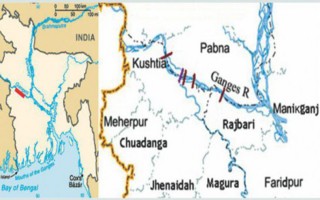Ganges Barrage Project shelved
The government on Wednesday announced that it abandoned the $ 4 billion Ganges Barrage Project, implementation of which awaited India’s consent until now.
The government also said that it would explore for an alternative option to optimize utilization of waters of the Ganges in Bangladesh.
The Ganges, Padma in Bangladesh, is one of the 54 common rivers between lower riparian Bangladesh and upper riparian India.
‘The project for the construction of the barrage on the Padma at Pangsa, Rajbari stands abandoned, water resources minister Anisul Islam Mahmud told a news conference after he held a meeting with a Chinese delegation at his secretariat office.
The adverse impacts of India’s Farrakka Barrage in Bangladesh, he said, ‘is under reexamination.’
Replying to a question, he said, a high-powered technical committee would be formed to find out an alternative option to optimize utilization of Ganges waters Bangladesh gets in the dry season under the 1996 Ganges Water Sharing Treaty with India.
The 30-year Ganges water sharing treaty is due to end in 2026.
Anis made the announcement a day after prime minister Sheikh Hasina called Bangladesh’s Ganges Barrage Project a ‘faulty and suicidal project’ for the country like the Teesta Barrage.
She described the study as well as the design for the now abandoned Ganges Barrage Project of Bangladesh as ‘faulty’.
Chinese water resources minister CHEN Lei, now in Bangladesh heading a six-member delegation of his country, held wide ranging discussions with Anis relating to implementation of Chinese assisted projects in Bangladesh’s water sector.
China earlier expressed its eagerness to provide both financial and technical assistances Bangladesh’s much-hyped project for the construction of Ganges Barrage at Pangsha .
It took Bangladesh government four years beginning 2009 to complete the feasibility studies for the Ganges Barrage construction spending Tk42 crore.
The 13-volume report weighing 23 kg providing design details was submitted to the government in 2013, said Ganges Barrage Project officials.
‘We will have to conduct fresh studies to find an alternative site and design for the project without obstructing the river flow,’ they told New Age.
Anis also said that India had already been approached for jointly constructing a barrage on the Ganges in Bangladesh.
The question now hovers over the design, said Anis.
He said foreign and local consultants conducted feasibility studies for preparing the Ganges Barrage construction project.
Construction of the Ganges Barrage was due to begin in 2014 and end in 2020.
On Tuesday, Sheikh Hasina announced at a news conference at Ganabhaban on return from her official trip to India that the barrage would be constructed jointly by Bangladesh and India.
She said that she already instructed the water resources ministry to find out alternative sites for the construction of a reservoir on a Ganges distributary for the storage of the monsoon flows of the Ganges for utilization during the lean period.
Hasina said that she also requested West Bengal chief minister Mamata Banerjee to look for sites in India for the same project.
During her visit to Delhi Hasina was expecting to make a breakthrough for the construction of her country’s Ganges Barrage and also break the deadlock over forging a Teesta water sharing deal.
Both the expectations were dashed, Hasina found out even while in the capital of India.
The delay had led to escalation of Ganges Barrage construction cost by $ one billion, when the project had to be abandoned due to unexplained reasons.
Checking salinity intrusion from the sea and storage of Ganges waters for irrigating crop fields and increased fish supplies for the growing population of the country provided the driving motivation behind Bangladesh’s Ganges Barrage Project.
The barrage was designed to preserve the unique biodiversity of the Sunderbans, the world’s largest mangrove forest and a global heritage site.
Project officials said that Bangladesh waited for years to get India’s ‘clearance’ to begin the barrage construction.
They said India was provided with feasibility study report of the barrage.
India had demanded further detailed reports about the barrage from where the issue saw no progress except for that New Delhi had sent as many as 19 questions relating to the now abandoned Ganges Barrage Project.
In April 2015, Sheikh Hasina issued a three-point directive in which she said that the Ganges Barrage would be a joint Bangladesh-India project to ensure uninterrupted natural flows of the Ganges- Padma in Bangladesh.
In April 1975, India commissioned the Farakka Barrage to divert Ganges waters for flushing the Kolkata port flouting a joint declaration by prime ministers Sheikh Mujibur Rahman and Indira Gandhi that India would not commission its Farakka Barrage until the two sides found a mutually acceptable sharing solution.
India’s withdrawal of Ganges waters from the upstream using the Farakka Barrage drastically reduced the river’s water flows in lower riparian Bangladesh adversely affecting its agriculture, fishery, forestry, navigation as well as industrial growth.
Salinity intrusion deep inside Bangladesh due to the low flows in the Ganges in dry months continues to pose threats to the biodiversity of the Sunderbans.
Since October last year there has been no progress though Bangladesh agreed to India’s proposal to hold a joint survey on the Indian side of the Ganges as India was keen to get the assurance that the proposed barrage in Bangladesh would not affect India.
In October last year, an eight-member Indian technical team visited the Ganges Barrage site on invitation from Bangladesh.
A joint technical sub group formed on recommendation from the Indian team is still holding a joint survey of the barrage site at Pangsha when Bangladesh government suddenly abandoned the entire barrage project.
- See more at: http://www.newagebd.net/article/13348/ganges-barrage-project-shelved#sthash.HAPw251w.dpuf











